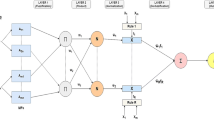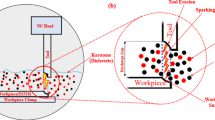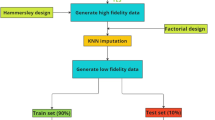Abstract
Machining operations involving complex multivariate parameters are defined by many machining parameters. Correct selection of these parameters is crucial for an efficient and economical cutting operation. The grooving operation required in many cases is one of the most problematic methods in all metal cutting operations, especially in terms of chip control. This paper covers theoretical analysis and mathematical modeling of deformation and stresses of the grooving tool. Cutting forces affecting the service life of the grooving tool were measured by various cutting experiments. Deformation and stresses of grooving tool caused by cutting forces were analyzed by finite element method using Ansys software. In modeling with artificial neural networks (ANN), grooving insert width, cutting speed, feed rate, radial force and primary cutting force are inputs in the model and deformation and stresses of the grooving tool are outputs. An algorithm, which is a Matlab script file, was developed to determine the optimal combination of neural network parameters such as the normalization method, number of hidden neurons, transfer function and training algorithm. The best-fitting set determined by the algorithm developed for the model was achieved with the Levenberg–Marquardt backpropagation algorithm, logistic sigmoid transfer function, nine hidden neurons and normalization method with a scaling factor. The MSE, R2, MAPE values of the ANN model are 2.0327 × 10−6, 0.999992 and 0.379227, respectively. Performance results have shown that the proposed approach can also be used for ANN modeling of machining parameters in other cutting operations other than grooving.










Similar content being viewed by others
References
Guemmour MB, Sahli A, Kebdani S et al (2015) Simulation of the chip formation and temperature distribution by the FEM. J Appl Sci 15:1138–1148. https://doi.org/10.3923/jas.2015.1138.1148
Necpal M, Pokorný P, Kuruc M (2017) Finite element analysis of tool stresses, temperature and prediction of cutting forces in turning process. Solid State Phenom 261:354–361. https://doi.org/10.4028/www.scientific.net/SSP.261.354
Yalçın B, Yılmaz N, Kurt A (2018) Tool stresses in soft and hard finish turning with low content CBN tool by finite elements analysis. Acta Phys Pol A 134:48–56. https://doi.org/10.12693/APhysPolA.134.48
Venkatesh SS, Ram Kumar TA, Blalakumhren AP et al (2019) Finite element simulation and experimental validation of the effect of tool wear on cutting forces in turning operation. Mech Mech Eng 23:297–302. https://doi.org/10.2478/mme-2019-0040
Kurt A (2009) Modelling of the cutting tool stresses in machining of Inconel 718 using artificial neural networks. Expert Syst Appl 36:9645–9657. https://doi.org/10.1016/j.eswa.2008.12.054
Gürbüz H, Sözen A, Şeker U (2016) Modelling of effects of various chip breaker forms on surface roughness in turning operations by utilizing artificial neural networks. J Polytech 19:71–83
Esim E, Yıldırım Ş (2017) Drilling performance analysis of drill column machine using proposed neural networks. Neural Comput Appl 28:79–90. https://doi.org/10.1007/s00521-016-2322-8
Karabulut Ş, Karakoç H (2017) Investigation of surface roughness in the milling of Al7075 and open-cell SiC foam composite and optimization of machining parameters. Neural Comput Appl 28:313–327. https://doi.org/10.1007/s00521-015-2058-x
Ulas HB, Ozkan MT, Malkoc Y (2018) Vibration prediction in drilling processes with HSS and carbide drill bit by means of artificial neural networks. Neural Comput Appl. https://doi.org/10.1007/s00521-018-3379-3
Laouissi A, Yallese MA, Belbah A et al (2019) Investigation, modeling, and optimization of cutting parameters in turning of gray cast iron using coated and uncoated silicon nitride ceramic tools. Based on ANN, RSM, and GA optimization. Int J Adv Manuf Technol 101:523–548. https://doi.org/10.1007/s00170-018-2931-8
Sureshkumar B, Vijayan V, Dinesh S et al (2019) Neural network modeling for face milling operation. Int J Veh Struct Syst 11:214–219. https://doi.org/10.4273/ijvss.11.2.20
Taşgetiren S (2000) An estimation of edge deterioration on cutting tool during turning: off-line stress analysis approximation. Afyon Kocatepe Univ J Sci 2:99–108
Mahnama M, Movahhedy M (2012) Application of FEM simulation of chip formation to stability analysis in orthogonal cutting process. J Manuf Process 14:188–194. https://doi.org/10.1016/j.jmapro.2011.12.007
Machai C, Iqbal A, Biermann D et al (2013) On the effects of cutting speed and cooling methodologies in grooving operation of various tempers of beta-titanium alloy. J Mater Process Technol 213:1027–1037. https://doi.org/10.1016/j.jmatprotec.2013.01.021
Abhyankar AA, Abhyankar AA (2016) Effects of machining parameters in turning process for grooving operation on aluminium and optimizing by the application of Taguchi method and Minitab 14 software. Int J Res Appl Sci Eng Technol 4:344–350
Saffury J (2017) Chatter suppression of external grooving tools. Proc CIRP 58:216–221. https://doi.org/10.1016/j.procir.2017.03.215
Zlamal T, Malotova S, Szotkowski T et al (2019) The geometry of grooving tool and its influence on dynamic load system for turning. Transp Res Proc 40:602–609. https://doi.org/10.1016/j.trpro.2019.07.086
Bakır S (2014) Investigation of the stresses affect cutting tool on a grooving to the outer surface (in Turkish). MSc Thesis, Gazi University, Turkey
Kurt A, Bakır S (2014) The effect of grooving tool width on cutting forces in grooving operation (in Turkish). Gazi Univ J Sci Part C Des Technol 2:221–228
Carbide Mitsubishi (2013) General Catalogue. Grooving tools, Mitsubishi Carbide, pp F04–F037
Zorev NN (1963) Inter-relationship between shear processes occurring along tool face and shear plane in metal cutting. Paper presented at International Production Engineering Research Conference, Pittsburgh, Pennsylvania, 9–12 Sept 1963, pp 42–49
Ucun İ, Aslantaş K, Karabulut A (2009) Investigation of variation in tool-chip contact length in orthogonal cutting process. J Fac Eng Archit Gazi Univ 24:477–484
Sheela KG, Deepa SN (2013) Review on methods to fix number of hidden neurons in neural networks. Math Prob Eng. https://doi.org/10.1155/2013/425740
Pitambare DP (2016) Survey on optimization of number of hidden layers in neural networks. Int J Adv Res Comput Commun Eng 5:537–540
van den Berg RA, Hoefsloot HCJ, Westerhuis JA et al (2006) Centering, scaling, and transformations: improving the biological information content of metabolomics data. BMC Genom. https://doi.org/10.1186/1471-2164-7-142
Nawi NM, Atomi WH, Rehman MZ (2013) The effect of data pre-processing on optimized training of artificial neural networks. Proc Technol 11:32–39. https://doi.org/10.1016/j.protcy.2013.12.159
Eesa A, Arabo W (2017) A normalization methods for backpropagation: a comparative study. Sci J Univ Zakho 5:319–323
Ertugrul ÖF (2018) Two novel versions of randomized feed forward artificial neural networks: stochastic and pruned stochastic. Neural Process Lett 48:481–516. https://doi.org/10.1007/s11063017-9752-x
Ertugrul ÖF (2018) A novel type of activation function in artificial neural networks: trained activation function. Neural Netw 99:148–157. https://doi.org/10.1016/j.neunet.2018.01.007
Karlik B, Vehbi A (2011) Performance analysis of various activation functions in generalized MLP architectures of neural networks. Int J Artif Intell Expert Syst 1:111–122
Bircanoğlu C, Arıca N (2018) A comparison of activation functions in artificial neural networks. In: 26th Signal Processing and Communication Application Conference, Izmir, pp 1–4. https://doi.org/10.1109/SIU.2018.8404724
Hu J, Xu L, Wang X et al (2018) Effects of BP algorithm-based activation functions on neural network convergence. J Comput 29:76–85
Maharajan C, Raja R, Cao J et al (2018) Global exponential stability of Markovian jumping stochastic impulsive uncertain BAM neural networks with leakage, mixed time delays, and α-inverse Hölder activation functions. Adv Differ Equ 1:113. https://doi.org/10.1186/s13662-018-1553-7
Altun Ş, Ertugrul ÖF (2018) Determining optimal artificial neural network training method in predicting the performance and emission parameters of a biodiesel-fueled diesel generator. Int J Autom Eng Technol 7:7–17
Matlab Help (2018) https://www.mathworks.com/help/. Accessed 8 July 2019
Shehab T, Farooq M (2013) Neural network cost estimating model for utility rehabilitation projects. Eng Constr Archit Manag 20:118–126. https://doi.org/10.1108/09699981311302991
Acknowledgements
This study was supported by Gazi University, Scientific Research Projects Unit (Project Code: 07/2012-36). As authors, we are grateful to the Gazi University Scientific Research Projects Unit for providing financing support in the realization of this study.
Author information
Authors and Affiliations
Corresponding author
Ethics declarations
Conflict of interest
The authors declare that there is no conflict of interest.
Additional information
Publisher's Note
Springer Nature remains neutral with regard to jurisdictional claims in published maps and institutional affiliations.
Rights and permissions
About this article
Cite this article
Kurt, A., Bakir, S. Theoretical analysis and mathematical modeling of deformation and stresses of the grooving tool. Neural Comput & Applic 32, 10481–10500 (2020). https://doi.org/10.1007/s00521-019-04588-w
Received:
Accepted:
Published:
Issue Date:
DOI: https://doi.org/10.1007/s00521-019-04588-w




